| DESCRIPTION | HISTORY |
Please Click On Any Picture for a Larger Version
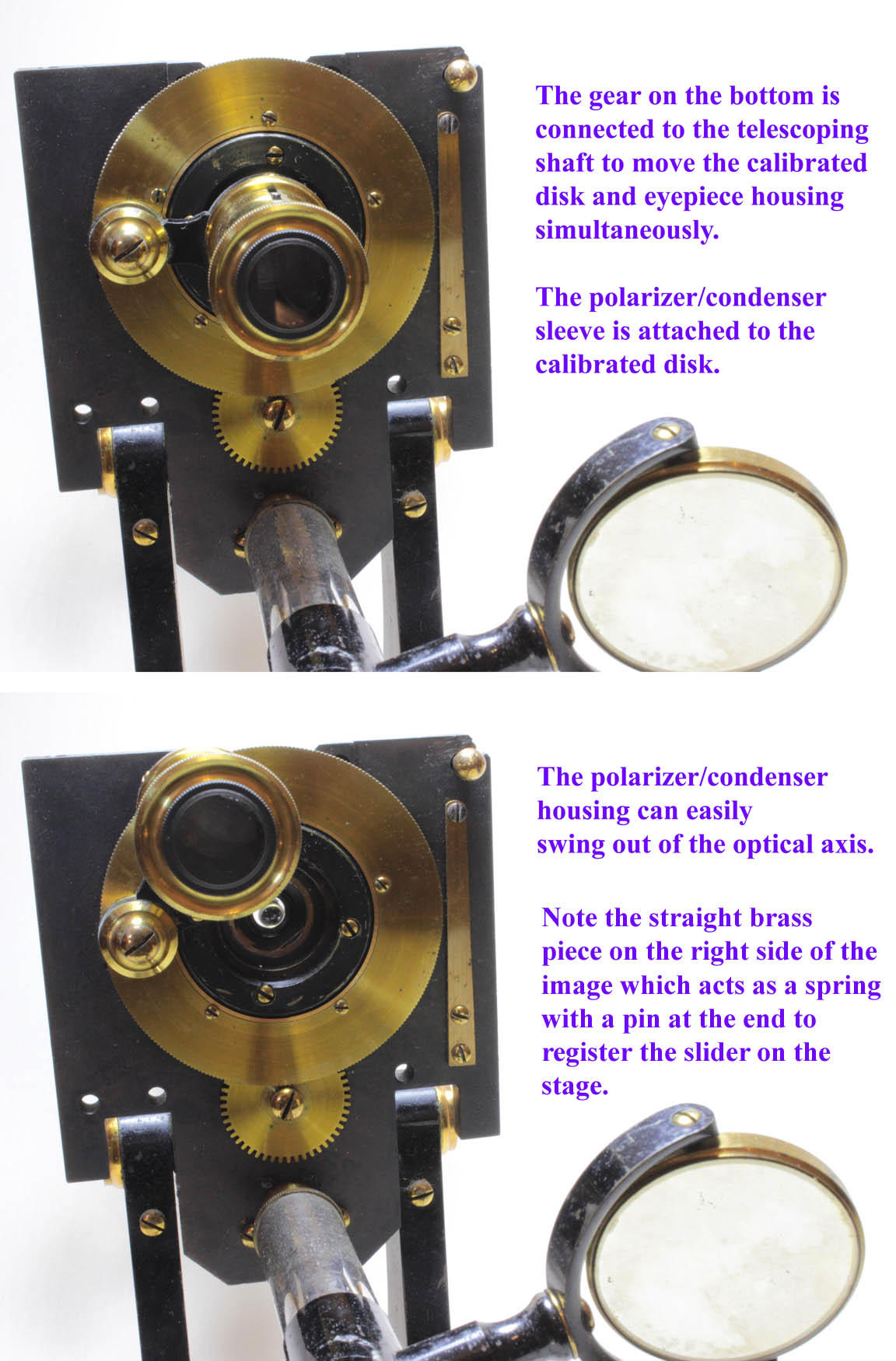 The square stage is about 3 5/8 inches wide, and has a substage sleeve that rides on a large geared calibrated disk with a silvered scale visible from the top of the stage, the bottom side being lacquered brass. The sleeve can hold the polarizer or the achromatic condenser (both present). The condenser and sleeve can be thrown out of the optical axis on a hinge.
The square stage is about 3 5/8 inches wide, and has a substage sleeve that rides on a large geared calibrated disk with a silvered scale visible from the top of the stage, the bottom side being lacquered brass. The sleeve can hold the polarizer or the achromatic condenser (both present). The condenser and sleeve can be thrown out of the optical axis on a hinge.  The nickel-plated polarizer housing has a pin to register it on the sleeve. It has a calibrated knurled lacquered brass knob with a stop for zero and an arrow in the barrel points at the degree scale.
The nickel-plated polarizer housing has a pin to register it on the sleeve. It has a calibrated knurled lacquered brass knob with a stop for zero and an arrow in the barrel points at the degree scale.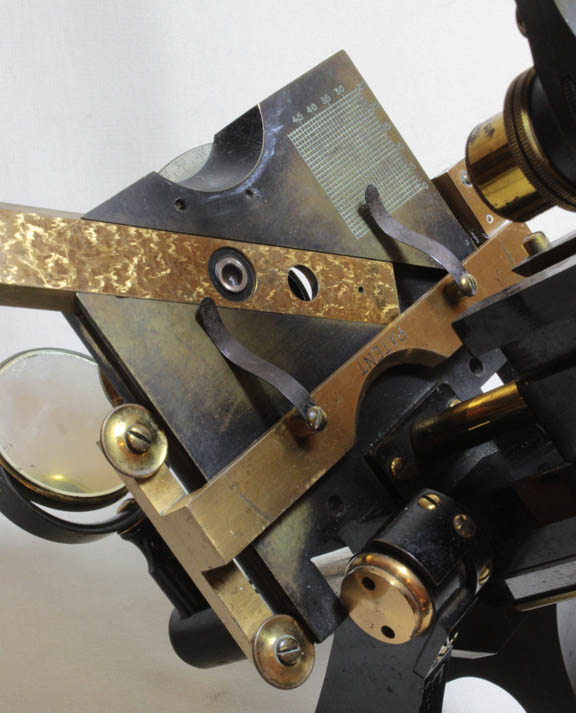 A slide holder attaches to the sides of the stage by rollers, two stationary on the left side and a spring-loaded one on the right. The rollers ride in slots machined into the sides of the stage for this purpose. Two spring-steel stage clips ride on this roller device. There are also two separate stage clips which fit into holes on the stage for stationary use without the roller device. A dovetailed slider fits in at a 45 degree angle from the left front corner. It has two 'empty' openings, one smaller than the other, which are fixed apertures, and a third oriface houses a convergent lens for use when viewing conoscopic images. The slider has three tiny holes that register its position against a pin sprung from the bottom of the stage.
A slide holder attaches to the sides of the stage by rollers, two stationary on the left side and a spring-loaded one on the right. The rollers ride in slots machined into the sides of the stage for this purpose. Two spring-steel stage clips ride on this roller device. There are also two separate stage clips which fit into holes on the stage for stationary use without the roller device. A dovetailed slider fits in at a 45 degree angle from the left front corner. It has two 'empty' openings, one smaller than the other, which are fixed apertures, and a third oriface houses a convergent lens for use when viewing conoscopic images. The slider has three tiny holes that register its position against a pin sprung from the bottom of the stage. 
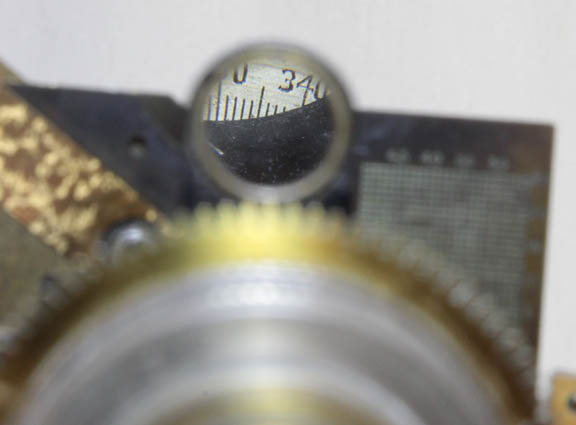 The optical tube has two Bertrand lenses, one on the lower end of the tube and another at the upper end. Both can be thrown in or out of the optical axis and both can be focused up and down within the tube. A double nosepiece is present. On the front of the optical tube is a fold out lens, housed in hard rubber, allowing the operator to read the silvered scale on the large disk at the stage from the top of the microscope; this is not possible when the double nosepiece is installed as pictured, but is possible with the double nosepiece angled instead of aligned front to back; this angled position was the usual way it was installed on a petrographic microscope.
The optical tube has two Bertrand lenses, one on the lower end of the tube and another at the upper end. Both can be thrown in or out of the optical axis and both can be focused up and down within the tube. A double nosepiece is present. On the front of the optical tube is a fold out lens, housed in hard rubber, allowing the operator to read the silvered scale on the large disk at the stage from the top of the microscope; this is not possible when the double nosepiece is installed as pictured, but is possible with the double nosepiece angled instead of aligned front to back; this angled position was the usual way it was installed on a petrographic microscope. A telescoping rod passes from the level of the bottom of the eyepiece through the arm of the microscope and through the stage. A gear at its top meshes with a gear that rotates the eyepiece housing, and a gear attached to its bottom meshes with the the large disk under the stage which attaches to the condenser sleeve. In this way, rotation of both the eyepiece housing (with analyzer) and the polarizer, rotate simultaneously.
A telescoping rod passes from the level of the bottom of the eyepiece through the arm of the microscope and through the stage. A gear at its top meshes with a gear that rotates the eyepiece housing, and a gear attached to its bottom meshes with the the large disk under the stage which attaches to the condenser sleeve. In this way, rotation of both the eyepiece housing (with analyzer) and the polarizer, rotate simultaneously. 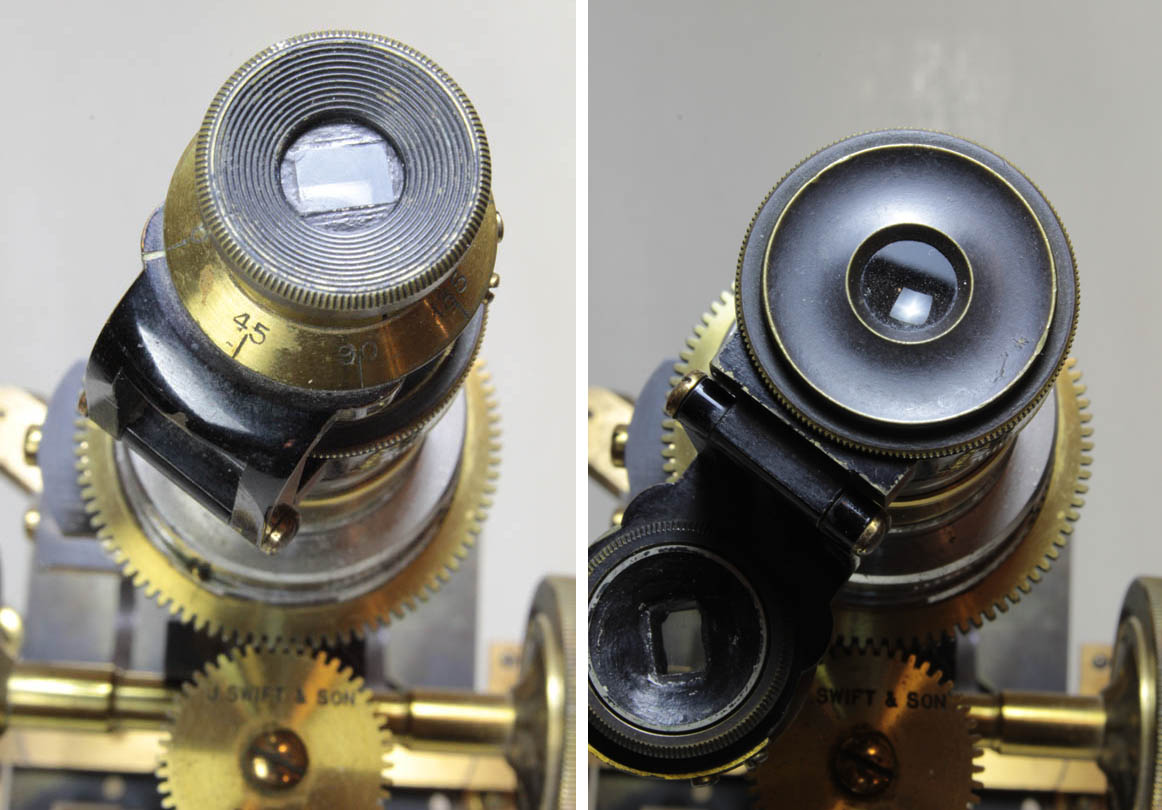
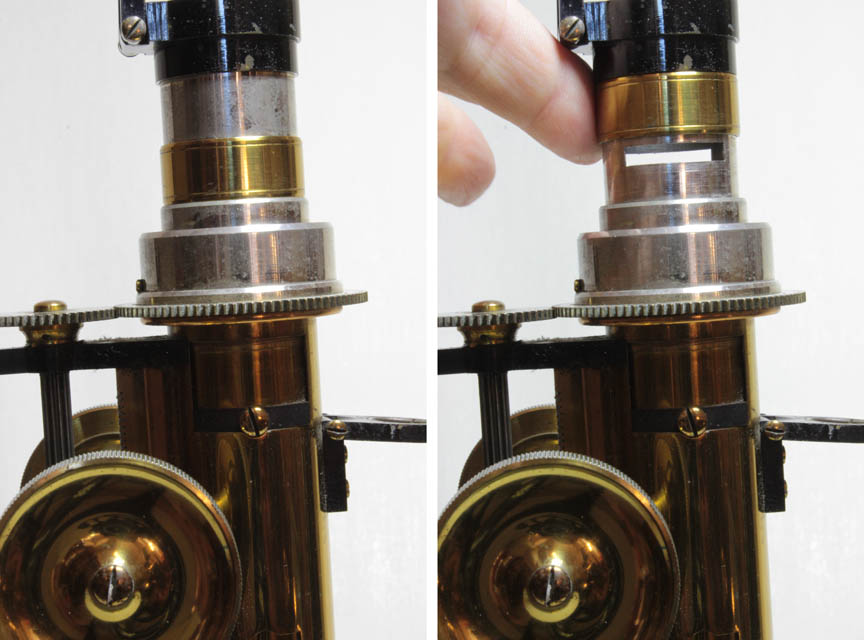 The analyzer sits over the eyepiece and is in a flip over attachement, making it easy to move out of the optical path. It can also rotate independently via a knurled calibrated scale, with stops. There is a slot in the upper tube to admit sliders such as a waveplate into a slotted eyepiece when it is present. The slot is covered by a dust cover which slides up and down.
The analyzer sits over the eyepiece and is in a flip over attachement, making it easy to move out of the optical path. It can also rotate independently via a knurled calibrated scale, with stops. There is a slot in the upper tube to admit sliders such as a waveplate into a slotted eyepiece when it is present. The slot is covered by a dust cover which slides up and down.  The microscope is about 13 inches high with a 1 inch objective focused on a slide, without the analyzer in place. The gear at the top of the telescoping rod is signed 'J. SWIFT & SON, PATENT'. The rolling slide holder is signed 'PATENT.' The fine focus knob has a diameter of about 41 mm (1 /58 inches), and is calibrated in 0.001 mm increments, labeled every 0.01 mm. The substage toothed silvered scale disk is calibrated in single degrees and labeled every ten. The stage has a calibrated grid engraved on its surface at the right side near the front for slide location. It is calibrated in both X and Y directions in mm. The foot is signed 'J. SWIFT & SON, LONDON'. The dovetailed hardwood case has green felt pads inside and a brass carrying handle. It has brass hinges and a brass lock. Lacking from this outfit are the key to the lock, the waveplates, and the slotted crosshair eyepiece.
The microscope is about 13 inches high with a 1 inch objective focused on a slide, without the analyzer in place. The gear at the top of the telescoping rod is signed 'J. SWIFT & SON, PATENT'. The rolling slide holder is signed 'PATENT.' The fine focus knob has a diameter of about 41 mm (1 /58 inches), and is calibrated in 0.001 mm increments, labeled every 0.01 mm. The substage toothed silvered scale disk is calibrated in single degrees and labeled every ten. The stage has a calibrated grid engraved on its surface at the right side near the front for slide location. It is calibrated in both X and Y directions in mm. The foot is signed 'J. SWIFT & SON, LONDON'. The dovetailed hardwood case has green felt pads inside and a brass carrying handle. It has brass hinges and a brass lock. Lacking from this outfit are the key to the lock, the waveplates, and the slotted crosshair eyepiece. 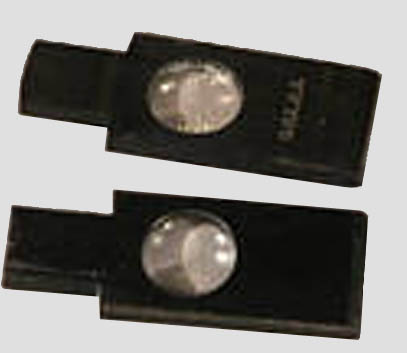 The original waveplates, no longer with this example, were housed in black hard rubber. Waveplates from another example of this microscope are shown here to the left.
The original waveplates, no longer with this example, were housed in black hard rubber. Waveplates from another example of this microscope are shown here to the left. 
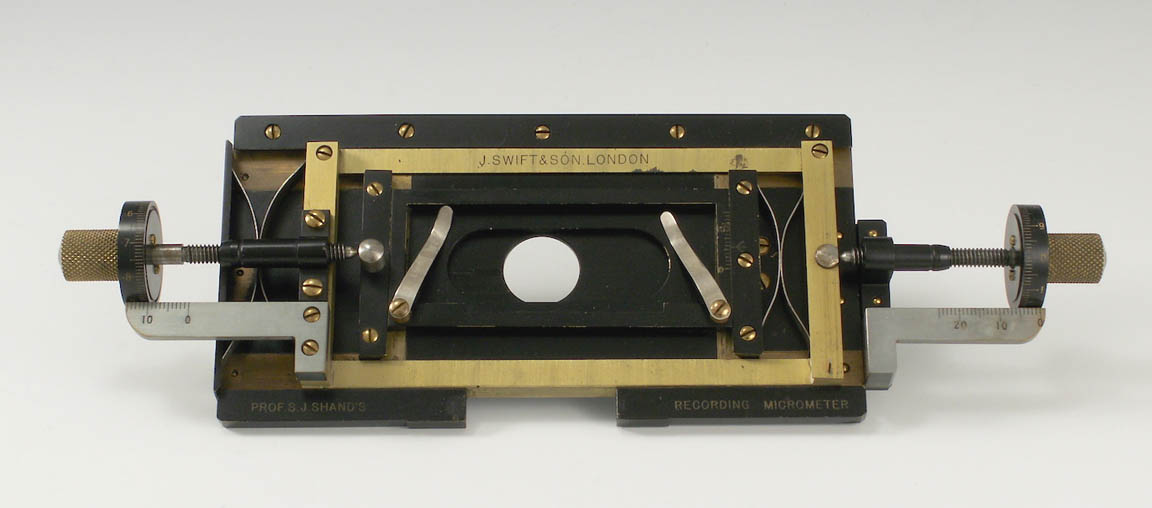 Other accessories were available for the Swift Dick microscope, and two of these are quite rare. One is the Meirs' stage goniometer(left), a complex instrument that allows precise rotation of a mineral grain. Another was a Shand's integrating stage(right), modified at the factory to fit the stage of the Dick model. The author is indebted to Dan Kile for these images from his collection. His superb articles should be consulted for more information about the history of the petrographic microscope7,8
Other accessories were available for the Swift Dick microscope, and two of these are quite rare. One is the Meirs' stage goniometer(left), a complex instrument that allows precise rotation of a mineral grain. Another was a Shand's integrating stage(right), modified at the factory to fit the stage of the Dick model. The author is indebted to Dan Kile for these images from his collection. His superb articles should be consulted for more information about the history of the petrographic microscope7,8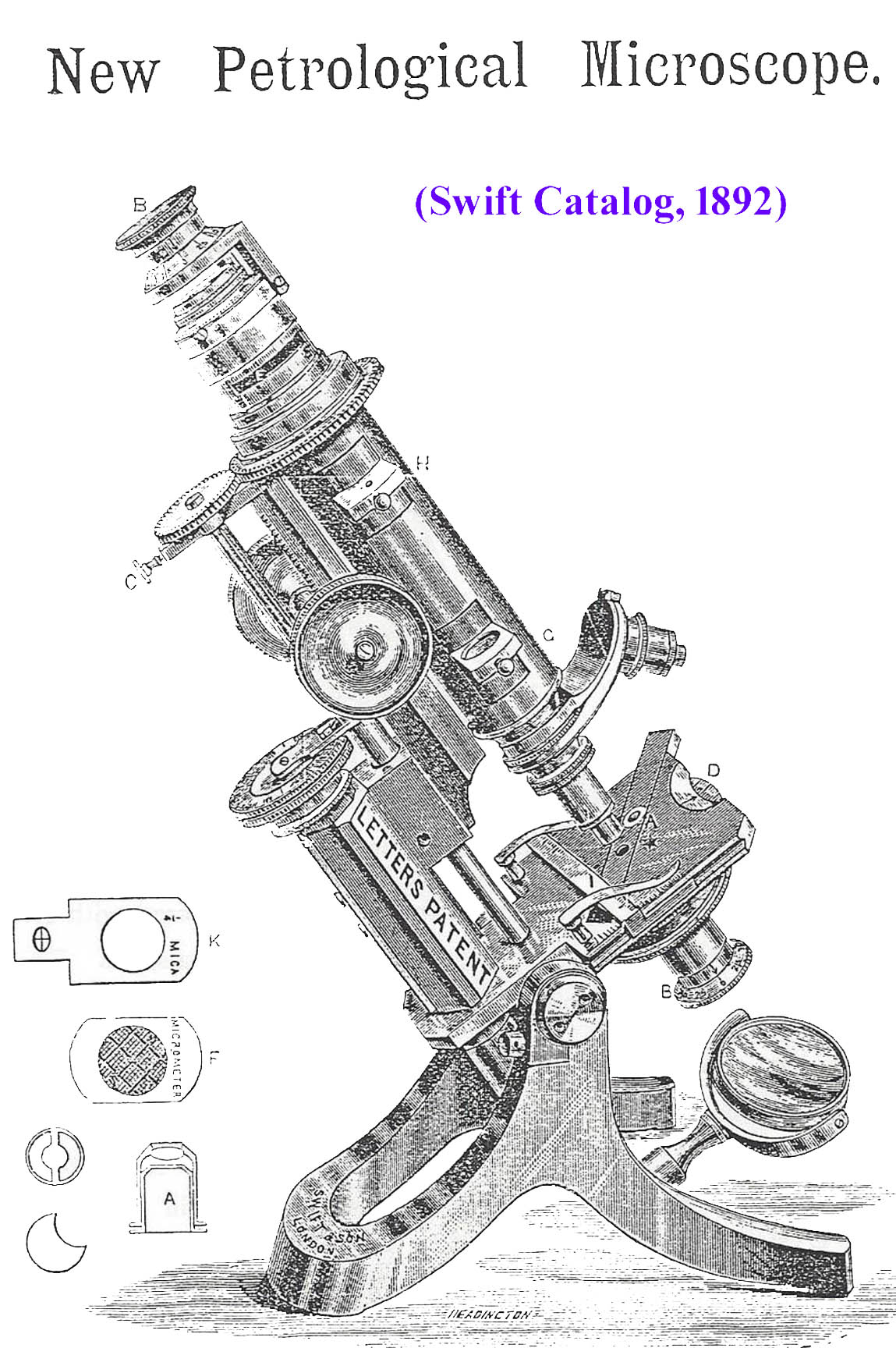 When the Dick model was first offered by Swift(left), it was called the 'New Petrological Microscope.' Other models soon followed and by 1892, the 'New Larger Petrological Microscope' was also offered. Besides being larger than the original form, this microscope featured a finely divided scale for rotation of the eyepiece with magnifier over vernier scale reading to 5' of arc. It also provided finer divisions in the fine focus knob to 1/5000 mm as opposed to 1/1000 mm in the orignal version.
When the Dick model was first offered by Swift(left), it was called the 'New Petrological Microscope.' Other models soon followed and by 1892, the 'New Larger Petrological Microscope' was also offered. Besides being larger than the original form, this microscope featured a finely divided scale for rotation of the eyepiece with magnifier over vernier scale reading to 5' of arc. It also provided finer divisions in the fine focus knob to 1/5000 mm as opposed to 1/1000 mm in the orignal version. 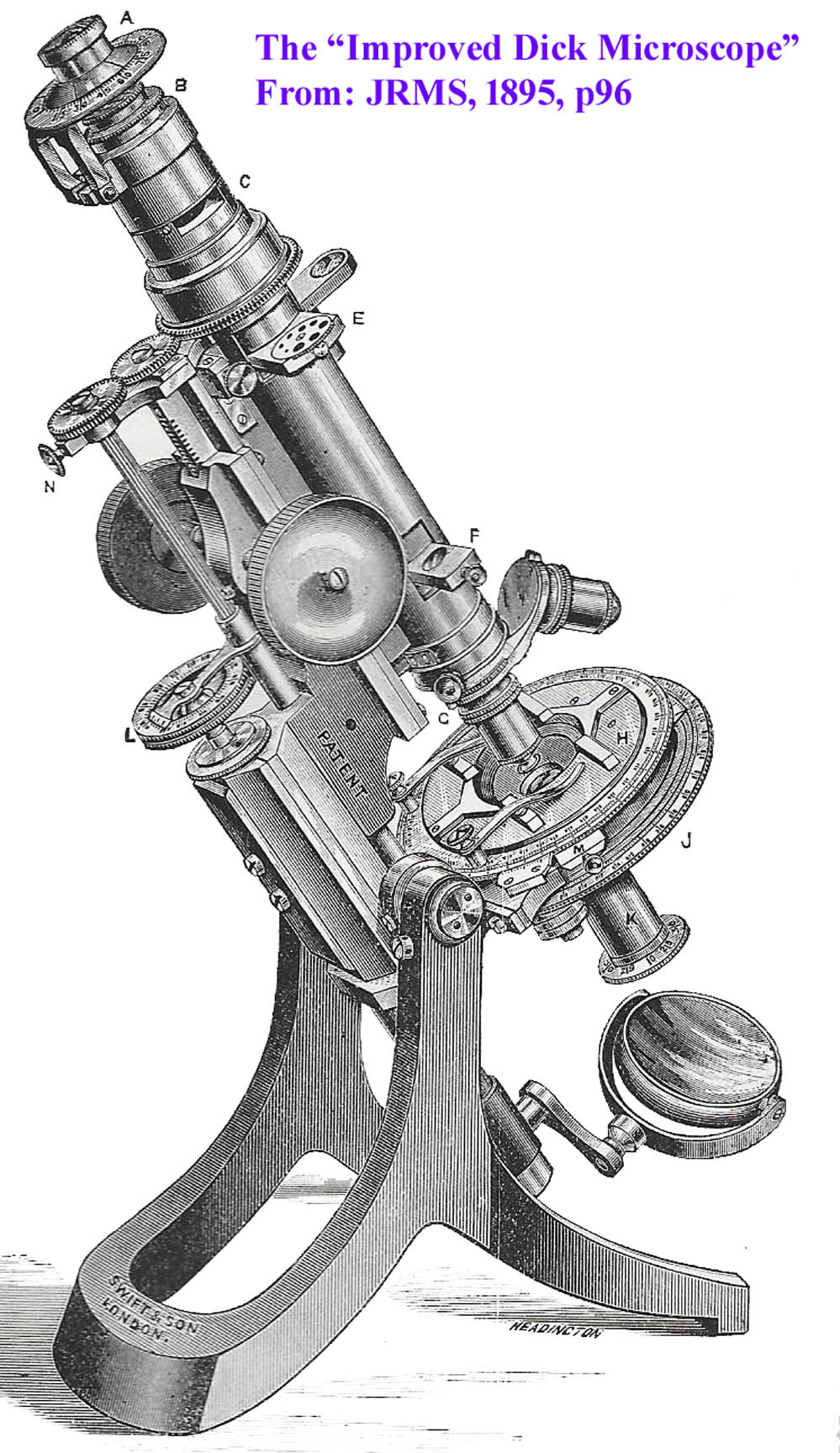 In 1895 an 'Improved Dick Petrological Microscope'(right), was reported in the JRMS5. This stand provided a calibrated rotating stage thus offering the user the choice of rotating the stage or the simultaneous rotation of the polarizer & analyzer. Another addition was a an iris diaphragm above the polarizer. The other new feature was a revolving disk of apertures for the upper slider, unlike the single choice in the original model. By 1895 all Dick models were provided with a flip-down magnifying lens attached to the body tube, which allowed reading the angle on the silvered understage polarizer disk without having to move far out of the optical axis nor get closer to the stage.
In 1895 an 'Improved Dick Petrological Microscope'(right), was reported in the JRMS5. This stand provided a calibrated rotating stage thus offering the user the choice of rotating the stage or the simultaneous rotation of the polarizer & analyzer. Another addition was a an iris diaphragm above the polarizer. The other new feature was a revolving disk of apertures for the upper slider, unlike the single choice in the original model. By 1895 all Dick models were provided with a flip-down magnifying lens attached to the body tube, which allowed reading the angle on the silvered understage polarizer disk without having to move far out of the optical axis nor get closer to the stage. 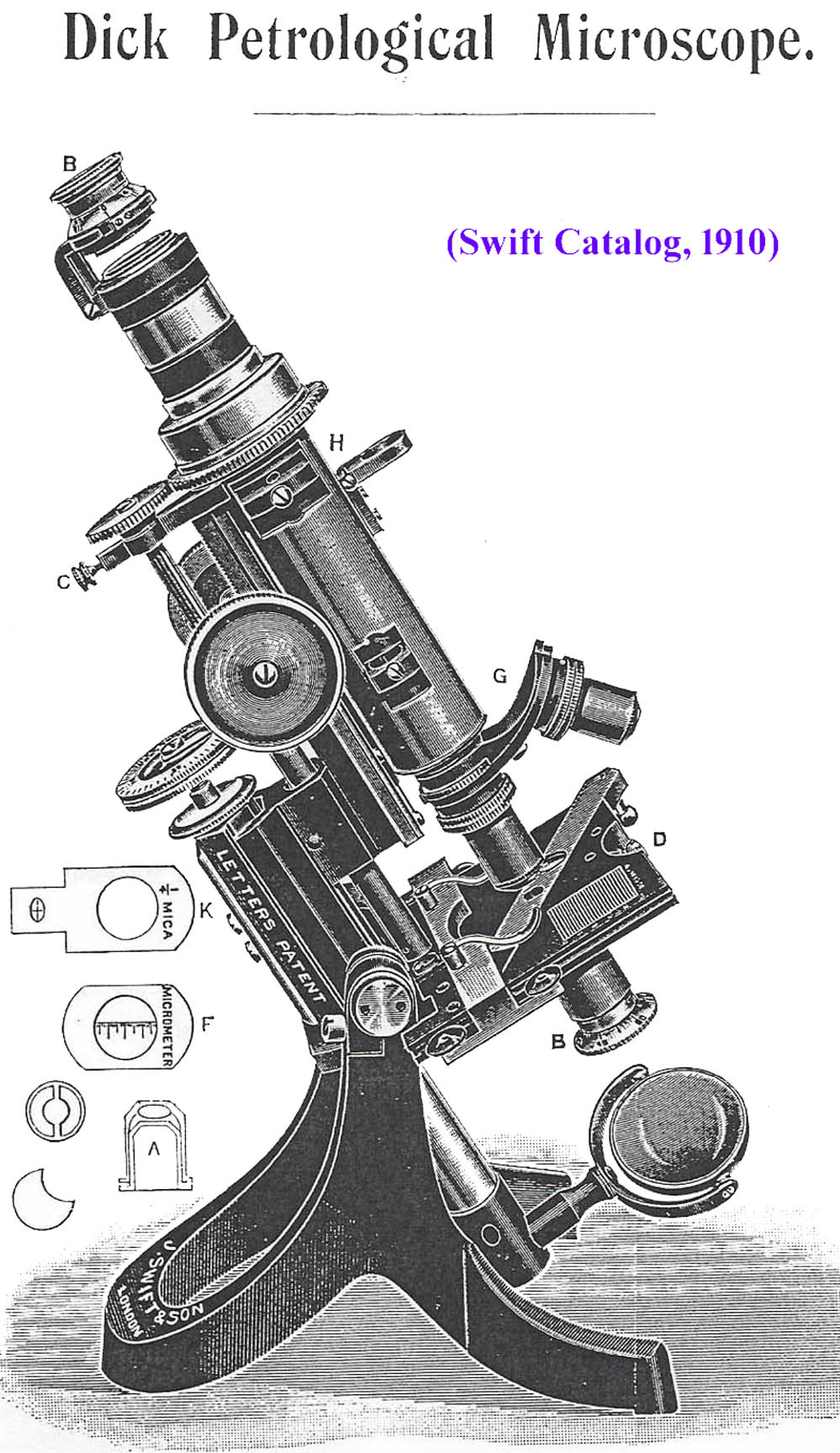
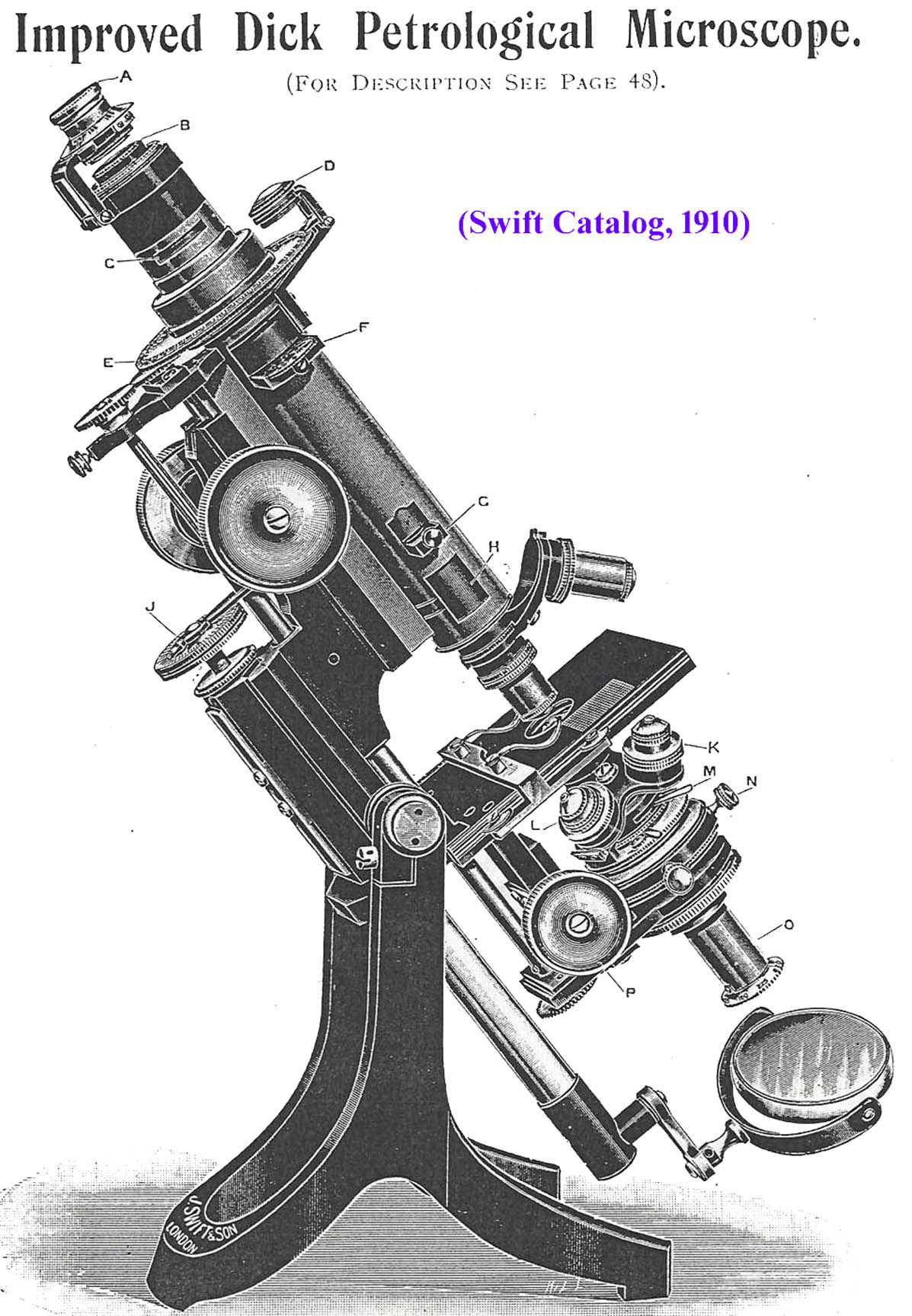 By 1910(left), the catalog called the original the 'Dick Petrological Microscope.' The features did not change. There was also offered the 'Large Model Dick Petrological' again with no illustration. A newer version of the 'Improved Dick Petrological'(right) featured the vernier scale for the eyepiece, but now a rack & pinion focused substage housing a revolving group of three different condensers above the polarizer. An iris diaphragm was interposed between these condensers and the polarizer. Further a swing-out holder in this apparatus accepted stops for dark ground and oblique illumination, as well as selenites and waveplates. This substage also had a centering adjustment. The stage was again square. With the vernier scale below the eyepiece, the understage graduated disk was eliminated.
By 1910(left), the catalog called the original the 'Dick Petrological Microscope.' The features did not change. There was also offered the 'Large Model Dick Petrological' again with no illustration. A newer version of the 'Improved Dick Petrological'(right) featured the vernier scale for the eyepiece, but now a rack & pinion focused substage housing a revolving group of three different condensers above the polarizer. An iris diaphragm was interposed between these condensers and the polarizer. Further a swing-out holder in this apparatus accepted stops for dark ground and oblique illumination, as well as selenites and waveplates. This substage also had a centering adjustment. The stage was again square. With the vernier scale below the eyepiece, the understage graduated disk was eliminated.
 An interesting fact is that in 1891 Swift also marketed a microscope(left) which also allowed simultaneous rotation of the polarizer and analyzer but instead of the internal gears, this microscope, called the 'Complete Petrographic' microscope, allowed this rotation through a bar coupling that stuck out in front of the microscope. This type of coupling was to become popular in the 1st quarter of the twentieth century and beyond.
An interesting fact is that in 1891 Swift also marketed a microscope(left) which also allowed simultaneous rotation of the polarizer and analyzer but instead of the internal gears, this microscope, called the 'Complete Petrographic' microscope, allowed this rotation through a bar coupling that stuck out in front of the microscope. This type of coupling was to become popular in the 1st quarter of the twentieth century and beyond.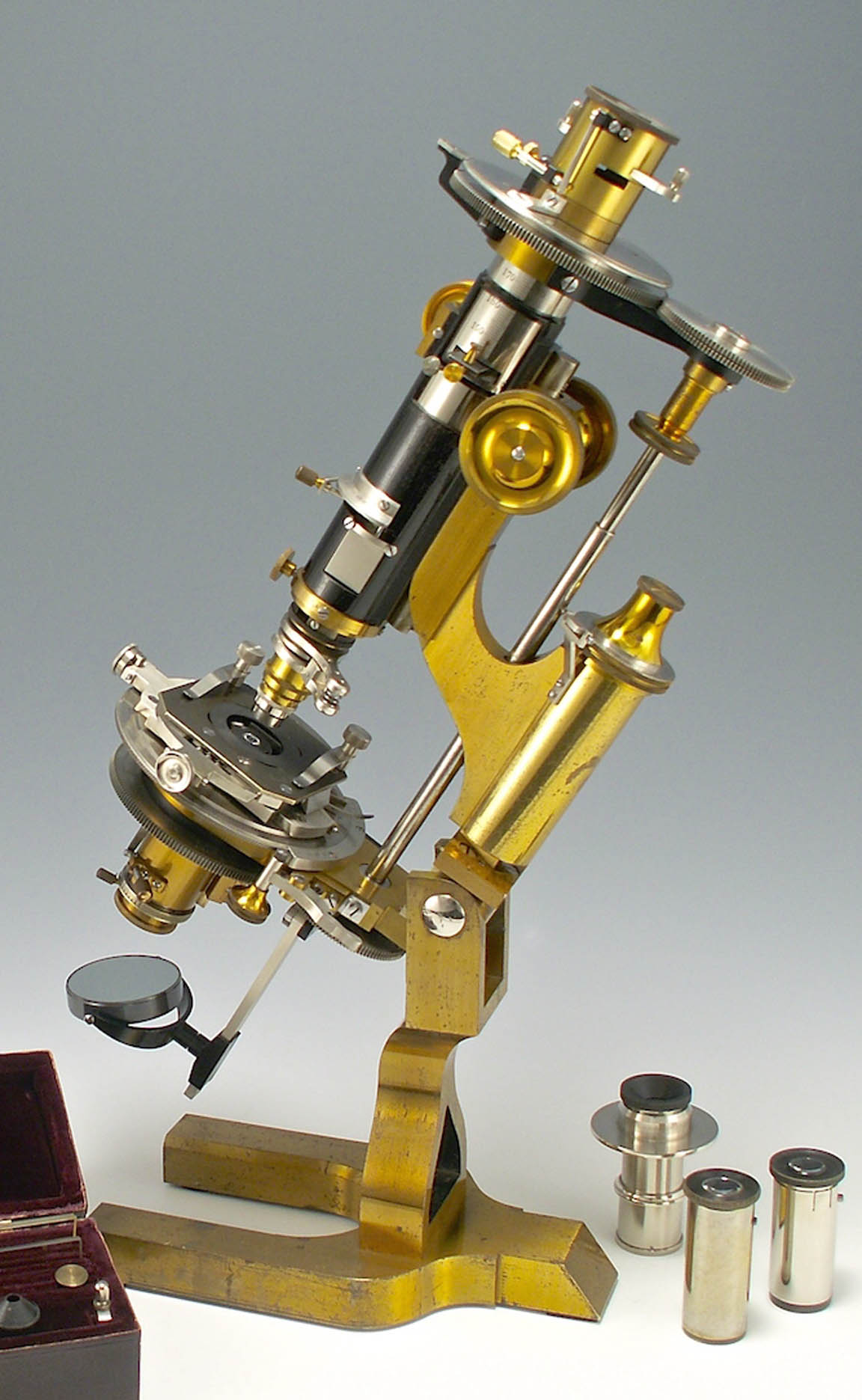 The Dick rotation mechanism was used by others such as Fuess in 1895(right), where the 'Model VI' had both stage rotation and gear rotation. The Dick mechanism was also used in their models VIIa and VIII. This image courtesy of, and collection of, Dan Kile.
The Dick rotation mechanism was used by others such as Fuess in 1895(right), where the 'Model VI' had both stage rotation and gear rotation. The Dick mechanism was also used in their models VIIa and VIII. This image courtesy of, and collection of, Dan Kile.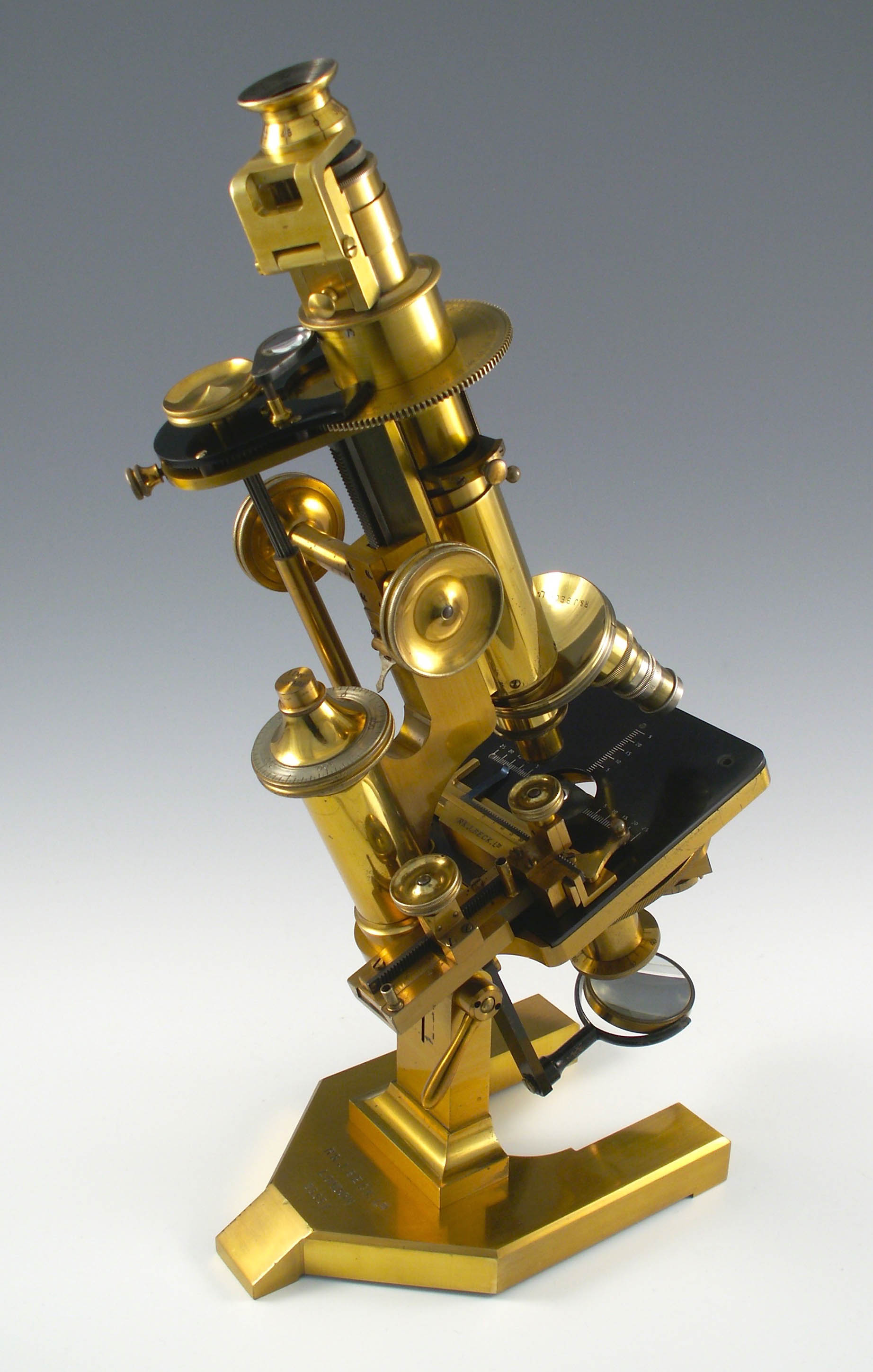 Another rare microscope using Dick's invention is the rare R & J Beck Dick model(left), which because of its much higher original cost, was never very popular and is therefore considerably rarer than the Swift model. This image courtesy of, and collection of, Dan Kile
Another rare microscope using Dick's invention is the rare R & J Beck Dick model(left), which because of its much higher original cost, was never very popular and is therefore considerably rarer than the Swift model. This image courtesy of, and collection of, Dan Kile